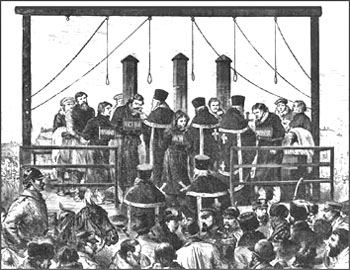Unit 12: The Revolutionary Movement
Executed on 3/15 April 1881 for their participation in the assassination of Alexander II one month earlier were Nikolai Kibalchich, Timofei Mikhailov, Nikolai Rysakov, Sofia Perovskaia and Andrei Zheliabov.

- Read the textbook pages 375-79 and 456-63.
- Check the remarks by Professor Blois and Professor Evans on the growth of the revolutionary movement.
- Study the Questions to Consider and the Key Terms for the Unit.
- Post (or respond) your thoughts/ideas about this Unit's reading and assignment in the Blackboard online discussion forum. Do not post your assignment there.
- Read some comments by George Kennan and Lev Deutsch on the tsarist government's practice of Siberian exile
- Read chapter 25 from Mary Platt Parmele (1843-1911) A Short History of Russia (1907, 4th edition). This is optional reading.
- In 1980 Professor Abbott Gleason published his engaging work on the Russian revolutionary movement, Young Russia: The Genesis of Russian Radicalism in the 1860s. Read some of Gleason's reflections on how he became interested in studying Russia and then later writing about the Russian radicals. (in *.doc or *.pdf format.)
- The Russo-Turkish War, 1875-1878, Professor Richard J. Evans, Gresham College Lecture
- Philip Pomper discusses his book, Lenin's Brother: The Origins of the October Revolution
- For extra credit please suggest to your instructor a relevant video for this unit of the course. Send the title of the video, the url and a brief explanation of why you find the video interesting and applicable to the material that is being studied in this unit.
- For 50 points maximum extra credit, read Franco Venturi, Roots of Revolution: A History of the Populist and Socialist Movements in 19th-Century Russia (Rev. Ed., 2001), one of the greatest scholarly works ever written about Russia--and it was written by an Italian--and write a one-page paper in which you explain the origins and development of the Russian populist movement.
- For 50 points maximum extra credit, read Fedor Dostoevskii, Notes from the Underground (1864) and write a one-page paper that provides insight into Russian society of the 1840s. There are some truly memorable scenes in the book, especially one involving a five-ruble note.
- For 50 points maximum extra credit, read Fedor Dostoevskii (1821-81), The Devils (1872) and write a one-page paper explaining his portrait of the Russian revolutionaries.
- For 50 points maximum extra credit, read E. H. Carr, The Romantic Exiles: A Nineteenth-Century Portrait Gallery (1933) and write a one-page paper in which you look at the personal side of the lives of the Russian revolutionaries. This is a great book!
- For 50 points maximum extra credit, read Nikolai Chernyshevsky, What Is To Be Done? (1863-65) and write a one-page paper in which you answer the question, "What was Chernyshevskii's answer to the question that he posed?"
- For 100 points maximum, do the wikipedia analysis paper on an entry connected to Russian history and culture.
- For 25 points maximum extra credit, read Sergei Nechaev's Catechism of a Revolutionary and write a paragraph that answers the question, What was the underlying political philosophy of Nechaev?
- For 25 points maximum extra credit, read Sergius Stepniak on Nihilism and Narodnichestvo and write a paragraph that answers the question, What were the basic characteristics of the Russian revolutionary movement according to Stepniak?